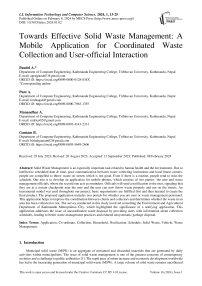Towards Effective Solid Waste Management: A Mobile Application for Coordinated Waste Collection and User-official Interaction
Автор: Paudel A., Pant A., Manandhar A., Gautam B.
Журнал: International Journal of Information Technology and Computer Science @ijitcs
Статья в выпуске: 1 Vol. 16, 2024 года.
Бесплатный доступ
Solid Waste Management is an especially important task related to human health and the environment. Due to ineffective scheduled date & time, poor communication between waste collecting institutions and local house owners, people are compelled to throw waste on streets which is not good. Even if there is a routine, people tend to miss the schedule. Our aim is to develop an application for mobile phones, which consists of two parties- the user and waste management officials, where the second one acts as reminders. Officials will send a notification to the user, signaling that they are at a certain checkpoint near the user and the user can now throw waste properly and not on the streets. An incremental model was used throughout our project; basic requirements are fulfilled first and then iterated to create the final product. The proposed application includes two portals for whether you are user or waste management personnel. This application helps to improve the coordination between clients and collectors and determines whether the waste in an area has been collected or not. The survey conducted in this study involved consulting the Environment and Agricultural Department of Kathmandu Metropolitan City, which highlighted the significance of a notifying application. This application addresses the issue of uncoordinated waste disposal by providing users with information about collection schedules, leading to better waste management practices and reduced unsystematic garbage disposal.
Application, Co-ordinate, Collection, Household, Notification, Schedule, Solid Waste, Vehicle, Waste Management
Короткий адрес: https://sciup.org/15018961
IDR: 15018961 | DOI: 10.5815/ijitcs.2024.01.02
Текст научной статьи Towards Effective Solid Waste Management: A Mobile Application for Coordinated Waste Collection and User-official Interaction
Municipal solid waste (MSW) is an aggregate of unwanted and discarded materials that are generated by daily activities within municipalities. The issue of solid waste management is one of the greatest concerns of contemporary societies and a challenge to public authorities [1]. The rapid pace of urban increase and economic development worldwide has led to the increasing generation of municipal solid waste (MSW). A large volume of solid waste remains uncollected in most of the metropolitan cities daily due to inappropriate collection, not collected in time and solid waste management (SWM) is a severe environmental concern in many developing countries [2]. Usually, Municipal Solid Waste Management (MSWM) of developing countries has across with five typical problems as: inadequate service coverage, operational inefficiencies of services, limited utilization of recycling activities, inadequate management of non-industrial hazardous waste, and inadequate landfill disposal [3].
The waste management framework in Nepal is well-established, with the Solid Waste Management Act of 2011 [8] and the Rules of 2013 [9] providing comprehensive coverage of all aspects of the waste stream. These regulations encompass everything from waste prevention and collection to the final disposal process. In the case of Kathmandu Valley which also includes Kathmandu Metropolitan City, the major factors that increase solid wastes and change the composition of waste (bio-degradable or non-degradable) are factory establishments, expansion of trade, advancement in technology and the general consumption habit of residents. Due to rapid population growth, the valley has seen rapid increment in volume of domestic and industrial waste along with health-related wastes as well which pose challenge in waste management and the environment itself. In this regard, the Solid Waste Management National Policy, 1997 [10] is the main policy document for managing solid waste. Solid Waste Management Act, 2011 and Solid Waste Management Rules, 2013 are other legal documents related to solid waste management.
Solid waste management (SWM) has also become one of the primary issues, especially in developing countries, due to the rapid and unmanaged urbanization [11]. Municipal solid waste (MSW) is generally a combination of household and commercial refuse generated by the living community [12]. Municipal solid waste (MSW) represents a significant issue in numerous urban areas across Nepal, particularly in densely populated cities like Kathmandu, Lalitpur, Biratnagar, Pokhara, and others [7]. As defined by the SWM Act of 2011, solid waste collection encompasses various activities, such as collecting waste from production sites, house-to-house collection, sweeping, depositing, weed uprooting, and gathering waste materials from public spaces. The proper and timely collection of waste generated from households and other sources is of utmost importance [13]. Municipalities are practicing door-to-door collection of waste from all households through a vehicle. This collection system is carried out by a municipality in coordination with other private and community sectors [14].
Taking the world into context, there have been a few applications that aid their respective governments in waste management. While some of the apps allow the user to choose their schedule for garbage collection, most of the applications are only advisory and primarily deal with how to separate degradable and non-degradable waste materials. Aside from the schedule, almost none of the applications notify the user of when the garbage collection vehicle is to arrive at their location. In case of Nepal, as of present, there have been no such applications that deal with solid waste collection in Nepal. The common way of collecting waste is to send a vehicle of some kind to a specific location and people are required to give away the waste to the vehicle. But most of the time, residents are not even notified and their last solution is to throw that waste on the side of streets which raises different problems related to health, sanitary, attraction and traffic. As the residents are unaware of the schedule of garbage collection and the officials are oblivious to the amount of garbage that is produced in a locality, the waste materials often are not collected on time and simply pile up where they are not wanted. Due to this a lot of roads and footpaths are filled with humongous piles of plastics and polythene bags to the point that pedestrians as well as motorists are forced to choose an alternate. If Nepal had a way to manage these problems, it would greatly benefit our country in different ways ranging from pollution reduction to utilization of degradable wastes as organic fertilizers.
2. Related Works
In context of world, applications do exist for garbage collection. WasteWORKS is an application that is designed to provide information about waste management in a comprehensive manner. The application provides users with data on waste management, recycling facilities as well as provides services like monthly billing and management reporting however actual connection between hauler and clients is missing [15]. Another application Trashflow is software designed for roll-off, residential, commercial and landfill waste management operations. Trashflow allows multiple services like electronic billing, dispatching, routing and vehicle tracking for waste collection businesses. This application also notifies the drivers of the suspended customers or those that are yet to pay their subscription fee so that they can skip those households. Trashflow also color codes the locations based on their priorities and whether they are private or commercial entities [16]. This application is more hauler focused than client oriented. Similarly, WasteConnect is an application that is designed for waste collection in multiple states of the United States of America. This application allows the user to keep track of their household's collection schedule and notify them. WasteConnect also has a function called “waste wizard” that helps the user find the proper disposal method for a given type of solid waste i.e., cutlery, food waste or glass bottles. The users are required to give their address so that the trash can be collected at the designated location [17].
While these applications somewhat address our objectives, their services are sadly not available in Nepal. Even with the existing systems in developed countries, there lacks a proper bridge between collectors and household owners. While some applications allow vehicle tracking, they only prioritize drivers and the users are kept in the dark while other systems are more user oriented with little to none functionality for the collection personnel. The application TrashFlow is designed for haulers and waste management companies and WasteWORKS is more statistical and lacks real time tracking. Also, while applications like WasteConnect are more fulfilling than the others, their services do not extend to all the states of the USA let alone Nepal. A lot of the waste collection apps also do not have functionality that allows the user to call for paid collection out of schedule or to mark whether their waste has been collected or not. Due to this, there seems to be a lack of coordination between households and haulers as the existing applications are unable to allow the two parties to communicate and synchronize together.
In the case of Nepal, there exist a few websites like that keep track of scrap dealers, bins, compost centers and recycling centers [18]. The above site also keeps track of waste collected, problems and frequency of waste collection. However as of present, there have been no developments in applications that directly aid in waste collection or management. Since there exists no application that work in sector of waste collection in Nepal, this alone is a limitation. While there have been numerous researches in this domain, utilization of a digital application for waste collection is still a novel context in Nepal. In Nepal, there have been studies and machine learning based solutions for electronic waste management and recycling [19], however collection of such wastes is still traditional and chaotic. Another research delves upon Bharatpur metropolitan city of Nepal and how it can improve the access to waste collection service from the administrative level including rescheduling the time of collection, optimal vehicle routing, street bins [20]. The use of digital technology for improving coordination is still not touched upon. In this context, this application will be very useful to improve the coordination between residents and waste collection officials by scheduling as well as notifying the users of when waste collection is taking place.
3. Methodology
This study has conceptualized and developed the proposed app, which brings significant innovations to waste collection and management. This application addresses limitations of existing apps and introduces novel features to enhance coordination, efficiency, and user experience. The main contribution of this work includes:
-
• Dual Portal System: We introduced separate portals for users and drivers, tailoring functionalities for their specific needs. Synchronized schedules facilitate seamless communication and coordination.
-
• Real-Time Notifications: Our real-time notification system enhances transparency between users and drivers. Users receive alerts for scheduled collections, while drivers are promptly notified of extra requests, optimizing efficiency.
-
• Flexible Unscheduled Collections: This enables users to request paid unscheduled collections, catering to urgent waste disposal needs.
-
• User Accountability: Users can mark waste collection completion, promoting transparency and accountability in the process.
-
• Coordinated Approach: Our core innovation fosters coordination between users and drivers, minimizing inefficiencies and communication gaps.
-
3.1. Operation Domain
Our application has been made with the primary goal of creating a systematic, convenient and traceable method for waste collection within the Kathmandu valley of Nepal. Inside we have chosen 16 municipalities with 3 metropolitan areas all of which have a population of over 75000 as per census 2021[census]. Each of these municipalities has ward numbers ranging from 9 to 32. The table-1 illustrates the municipalities that we have considered for our project.
For the solution to managerial problems in waste collection in Kathmandu valley, we have designed a prototype application that aims to improve the communication between the waste haulers and households. For this project we have used Flutter as our main front-end tool that will be used to create all the interfaces that are used to interact with users. The entire application is built using Flutter framework and for the back-end and designed this prototype using Firebase. The concept is very much scalable and easy to migrate to other backend preferable Django or NestJs in case of large number of clients and availability of larger servers. The flowchart of the system is present in Fig. 1.
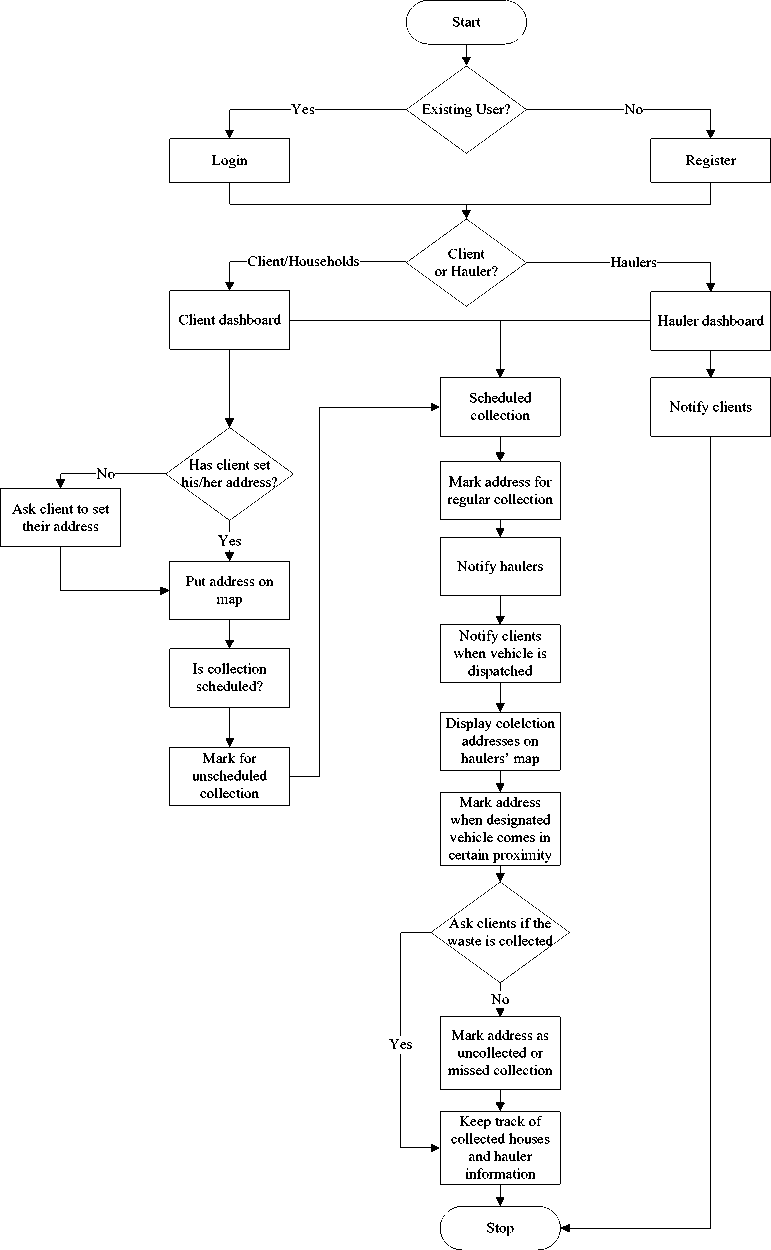
Fig.1. Flow chart of system
The methodology has been employed in developing the proposed waste collection application effectively aligns with the stated objectives, creating a systematic and efficient approach to waste management while facilitating communication between waste haulers and households. The application is designed to offer a systematic, user-friendly, and traceable method for waste collection. By utilizing Flutter for the front-end, users are presented with intuitive interfaces that allow them to easily interact with the application. The utilization of Firebase as the back-end framework ensures data integrity and real-time synchronization. This combination streamlines the waste collection process, making it convenient for both waste haulers and households to engage in coordinated waste disposal activities. The core functionality of the application addresses the need for timely notifications and communication. The notification system, which is based on the real-time location of waste haulers, notifies clients about the status of waste collection, including alerts when a vehicle is in route to their locality or has arrived in close proximity. This immediate and transparent communication ensures that clients are informed about upcoming waste collection events, achieving the objective of systematic and informed waste disposal.
This application mainly aims to bridge the communication gap between the clients and the haulers. For this we have a notification system that, based on the location of the hauler, notifies the client if a vehicle has left for their locality or if the vehicle has already arrived with certain proximity. The clients can pick their address with precise ward numbers and their location on a map which will be used to calculate the proximity of vehicles and households. The map service that we are using for this application is Mapbox and Firebase cloud messaging (FCM) is used for sending notifications.
Additionally, the application provides a channel for clients to raise complaints regarding waste collection. This feature allows clients to voice their concerns and contribute to the continuous improvement of the waste management process. By incorporating this feedback mechanism, the application empowers clients to actively engage with the waste collection process and contribute to its efficiency.
Table 1. Overview of municipalities considered for the project
|
S.N. |
Name of Municipality |
No. Of wards |
Population |
Location in latitude/longitude |
|
1 |
Kathmandu |
32 |
845,767 |
27.7172°N, 85.3240°E |
|
2 |
Lalitpur |
29 |
299,843 |
27.6667°N, 85.3167°E |
|
3 |
Bhaktapur |
10 |
78,854 |
27.6722°N, 85.4278°E |
|
4 |
Tokha |
11 |
135,741 |
27.759°N, 85.3283°E |
|
5 |
Budhanilkantha |
13 |
179,688 |
27.7667°N, 85.3667°E |
|
6 |
Tarakeshwar |
11 |
151,508 |
27.7867°N, 85.30306°E |
|
7 |
Gokarneshwar |
9 |
151,200 |
27.73°N, 85.3833°E |
|
8 |
Suryabinayak |
10 |
137,971 |
27.6667°N, 85.4000°E |
|
9 |
Chandagiri |
15 |
136,928 |
27.6903°N, 85.2203°E |
|
10 |
Kageshwari-Manohara |
12 |
133,327 |
27.7258°N, 85.4117°E |
|
11 |
Thimi |
9 |
119,955 |
27.6806°N, 85.3819°E |
|
12 |
Mahalaxmi |
10 |
118,710 |
27.645°N, 85.37°E |
|
13 |
Nagarjun |
10 |
115,507 |
27.7325°N, 85.2567°E |
|
14 |
Kirtipur |
10 |
81,782 |
27.6781°N, 85.2770°E |
|
15 |
Godawari |
14 |
100,972 |
27.6°N 85.37°E |
|
16 |
Changunarayan |
9 |
88,612 |
27.7167°N, 85.4297°E |
|
Total |
219 |
2,905,061 |
-
3.2. User Authentication
-
3.3. Address Mapping
For old users, we have a login option. The new users can register and verify their accounts before being able to utilize the services. To ensure that not everyone can create accounts with simply email addresses, we have created a database system with phone numbers and corresponding names such that only if the phone number exists in the database can an account be created and verified. To add the names and numbers, a user will have to contact the authorities. Beyond that point everything can be done from Haulers and clients will have different accounts and clients will not be able to access the hauler dashboards, but hauler accounts can also behave as client accounts considering the fact that waste haulers are automatically listed as clients and can utilize the client services from the same organization. For this purpose, the dependencies used in the application were: firebase_core version 1.23.0, firebase_auth: version 3.10.0 and firebase_analytics: version 9.3.6.
For maps in our application, we are usingMapbox’s street JavaScript map. We allow the clients to choose their address on a map and save the address. This address will be viewed by the haulers when they come for collection and based on this address, a notification will be sent. The address points are saved as latitudes and longitudes. The haulers can also view the locations as per schedule using this map along with client addresses. The chosen location also centers on the co-ordinates given in the previous table. For this the flutter dependencies we have used are: flutter_map: version 2.2.0, latlong2: version 0.8.1, location: version 4.4.0, mapbox_gl: version 0.16.0. To send the notification based on proximity to clients’ coordinates, we use the Haversine formula:
d =2* R * arcsin (√ ( sin ² (( blat - alat )/2) + cos ( alat )* cos ( blat )* sin ² (( blng - alng )/2))) (1)
Where:
-
d is the distance between points A and B in meters.
R is the Earth's radius, approximately 6,371 kilometers.
alat and alng are the latitude and longitude of point A in radians. blat and blng are the latitude and longitude of point B in radians.
To convert latitude and longitude values from degrees to radians, we used the following formulas:
radians = degrees * π /180
latl = initials[i].latitude * 3.1415926535897 / 180;
longl = initials[i].longitude * 3.1415926535897 / 180;
lat2 = locationData.latitude I * 3.1415926535897 / 180;
long2 = _locationData.longitude! * 3.1415926535897 / 180;
a = pow(sin((latl - lat2) / 2), 2) + cos(latl) * cos(lat2) * pow(sin((longl - long2) / 2), 2); distance = 6371000 * 2 * atan2(sqrt(a), sqrt(l - a));
3.4. Scheduling
3.5. Notification
4. Results4.1. Implementation of the Application
4.2. Deployment of the Application
Primarily in the case of Kathmandu valley, waste collection is done twice a week. In recent days it is mostly 2 days one for degradable and another for non-degradable wastes. Keeping that in mind, we have created this prototype where all the 219 wards have 2 days of collection per week. Based on the schedule, the clients are notified 1 day in advance so that they can prepare for the collection usually because collections take place in the morning. The schedule is stored in a database and notifications are based on it so that even when clients change their address, the application will still be accurate .
The notification sent a day earlier will be a push notification and a local one. The notifications that are sent when a hauler leaves or when a hauler reaches in proximity are alert notifications and are sent using Firebase Cloud Messaging (FCM). These notifications also sound different from default notification sounds and are sent to devices using unique identifiers called device tokens. The device tokens for devices are stored in databases when a client logs in and are removed when a client logs out so that when there is no device on which a client is logged in, no notification is sent to the client. Messaging and notification services utilize these dependencies: firebase_messaging: version 13.1.0, flutter_local_notifications: version 12.0.4 and http: version 0.13.5.
Our application was found able to notify the users in most areas of Kathmandu valley about when the garbage haulers are reaching their location as well as allow them to complain about uncollected waste or ask for unscheduled but paid collection service at any time. Our goal was to create a system that will help clients and officials communicate better through technology.
This application is built based on the proposed waste collection application. The major portion of application is built using the Flutter framework, Flutter being the primary software used to create the front-end. Considering it is only a prototype we have used firebase as the backend but switching to actual server using Django and NestJS for backend is also viable as the application is scalable and modular. The map services used are from Mapbox Studios and we are using a street map for our application. The entire application was developed in a Windows 10 64-bit environment.
The application was tested on multiple devices using debug mode when under development and once completed through the means of APK in Android mobiles. There were no bugs or unforeseen circumstances that arose on these devices while using various means of installations and in every case the application was installed successfully. This helped with proper maintenance or configuration changes during updates.

Fig.2. Level 0 dataflow diagram of application
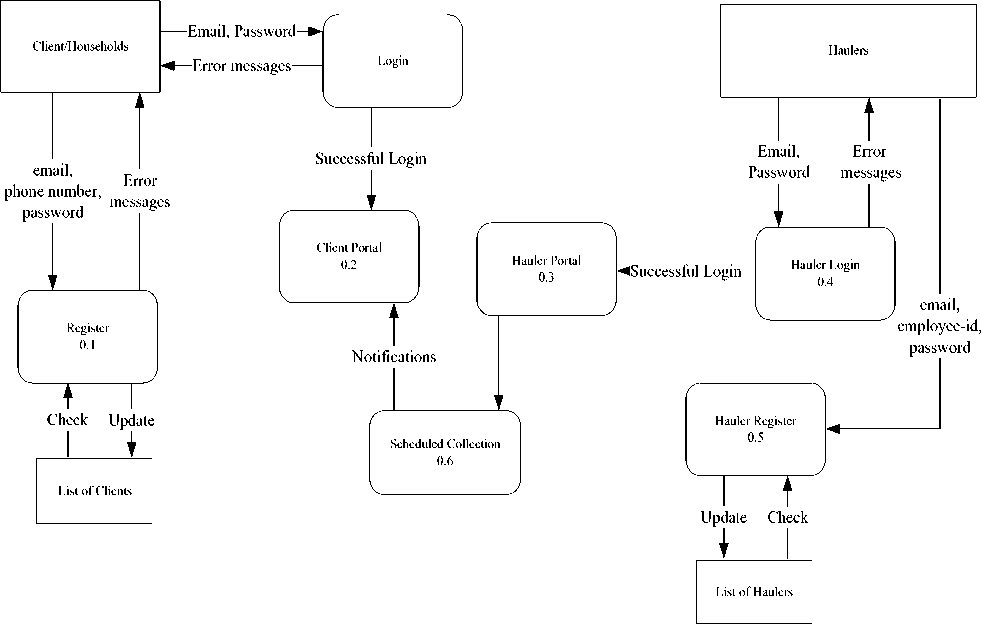
Fig.3. Level 1 dataflow diagram of application
In our system, we have 2 portals, different ones for clients and haulers, as proposed. The registration for clients and haulers is also done differently and the databases for both of these are also different. Both the portals are then used to access the services that are promised to clients and haulers respectively.
Front-end
Back-end
Client Side Infrastructure
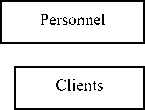
Fig.4. System architecture of application
User Interface: Flutter
Storage: Firebase
Management
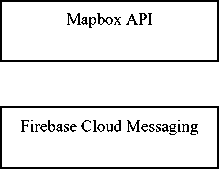
5. Evaluations
In this section, an evaluation of the application is presented. During our comprehensive testing phase, we employed a thorough methodology involving the utilization of 15 distinct email addresses among our team of four members. This rigorous testing encompassed several pivotal aspects of the proposed application's functionality, culminating in a robust assessment of its performance.
In the initial phase, we subjected the login and registration processes to meticulous scrutiny. The registration procedure, which involved the input of email, password, and phone number, was designed with precision. Notably, successful registration was contingent upon the phone number's presence in the database, an approach that bolstered data integrity. Furthermore, we confirmed that each phone number could be used only once, preventing redundant registrations. This examination was conducted across multiple instances, affirming the application's seamless handling of these crucial processes. The successful execution of registration across multiple instances affirms the application's adept handling of this critical process.
In the subsequent testing stage, we focused on the map functionality and location-based features. We meticulously verified the visibility and layering of the map, ensuring its user-friendliness and intuitive design. A pivotal aspect of this phase involved assessing the application's capability to enable clients to mark addresses on the map by tapping specific locations. This process was carefully evaluated to confirm the system's responsiveness and accuracy. Crucially, our tests validated the successful synchronization of hauler and client locations upon address updates, underscoring the consistent achievement of map-related functionalities. The successful synchronization of hauler and client locations upon address updates further demonstrates the application's reliability.
Moving on to the third phase, we rigorously evaluated the application's notification system. This involved scheduling local notifications to be sent at 8:00 PM Nepalese time (GMT+5.45) on the day preceding waste collection. Additionally, we tested the system's adeptness in sending alert notifications as haulers embarked on collection activities and when they departed for collection in clients' areas. These examinations accounted for potential variations in network conditions, confirming the application's steadfast ability to transmit notifications successfully as long as a stable internet connection was maintained. Furthermore, we verified the successful reception of similar alert notifications when haulers reached the proximity of addresses set by clients, showcasing consistent results with a slight delay of 5-10 seconds. The systematic scheduling of local and alert notifications, coupled with testing under varying network conditions, substantiates the application's consistent and successful notification transmission capabilities.
In the fourth testing phase, we thoroughly assessed client interactions, including complaints, credential updates, and requests. This encompassed a meticulous evaluation of backend updates in response to user actions, as well as the effective processing of user-initiated complaints and requests. Additionally, we ensured the visibility of clients' requests on the hauler portal, confirming that all these processes were executed without discrepancies. This extensive evaluation of user-centric interactions underscores the application's robustness.
To further enhance user experience, an address lock mechanism was introduced. This measure prevented address updates on the client's side once a hauler had accepted a request, mitigating potential miscommunications and ensuring seamless interactions.
22:27 65 Ie ^.nl89%i^
Registration *=
Register new account using correct credentials.
Enter email
Enter password
Enter name
Enter phone number
Register
Already registered?
Ill о <
-
Fig.5. UI related to registration shown in screen of application
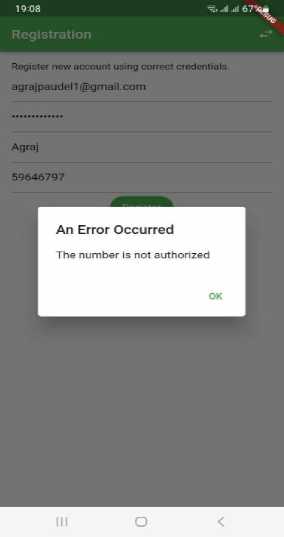
-
Fig.6. Dialog box for invalid number during registration
22:24 И f»
4. „il 89%

<- Unscheduled Collection
Current request:

Cancel Request
New Request: Selected: Dumptruck

Request Successful
Your request has been successfully

OK
Confirm Request
-
Fig.7. Dialog box requesting for unscheduled, paid request

Waste Collection
Hauler on the way
Price: 650
Vehicle: Dumptruck
Time: 2023-02-21 22:37:19.753131
Cancel Request
New Request:
Selected:
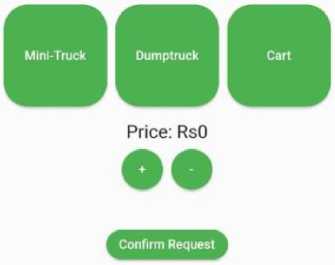
-
Fig.8. Dialog box confirming that the request is successful
The figure. 7 on the left shows a dialog box about hauler requesting for unscheduled but paid request and figure. 8 on the right is a dialog box confirming that the request is successful. The image on the right is a notification for the client for unscheduled collection if a hauler is leaving for his request. This notification uses the Firebase Cloud Messaging service to deliver its payload. Similar notifications are also sent for scheduled collections and a local notification is sent a day before the collection so that the clients are prepared.
a wastecollectomepal
+ Start collection
Complaints
List_of„tokens
Regular-collection
Schedules
[■ unscheduled_collection — ;
+ Add document
4- Start collection
+ Add field city: "Budhanilkantha"
last hauler:
latitude: 27.676721916381453
longitude: 85.27799700895855
number: *7601Г price: 640
time: '2023-08-23 21:01:54.012675* unscheduled_request: "requested" vehicle: "Dumptruck*
Fig.9. Firebase backend containing information about a user’s request
6. Conclusions
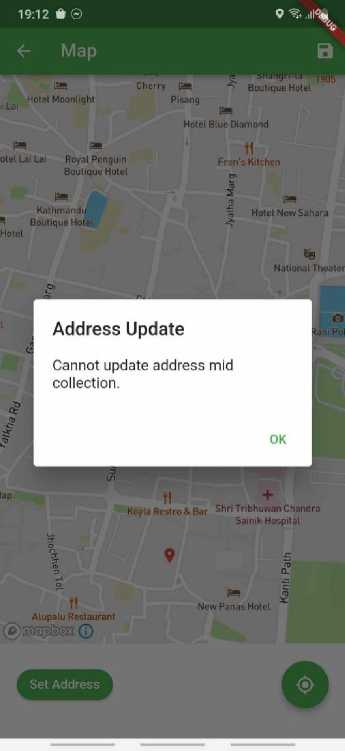
Fig.10. Dialog box showing that address cannot be updated when hauler has accepted request for collection to prevent miscommunication
Figure 9 shows the backend where all the information of user’s requests is stored. They store price, phone number (in this case a dummy), time and vehicle. Once the request is completed, the unscheduled_request field is going to store date/time of collection completion. Figure 10 shows the dialog box popping up when the user tries to change the address when hauler has accepted request for collection at his old address.
All of the tests were successful. These results demonstrate that the application is working as intended and meets the specified requirements. Moreover, the successful tests indicate that the application can be implemented in a real-world scenario, such as Nepal, with a high level of confidence in its functionality.
Thus, in this project, we created an application that can take in user data and allow the hauler to notify the user when they arrive at their place automatically. The users can also complain through the application and ask for unscheduled requests for additional collection (in form of paid service).
In conclusion, our project introduces a pioneering prototype application that addresses critical waste collection challenges in metropolitan environments, with a focus on Kathmandu valley and its 16 municipalities encompassing 219 wards. This application serves as a practical solution, offering a systematic and user-friendly approach to waste management. The scalability of our application extends beyond its initial scope, with the potential to be adapted to other metropolitan areas and cities grappling with similar waste collection issues.
The scientific justification lies in our method's adaptability and scalability. The application's need in Kathmandu valley serves as a testament to its potential application in other metropolitan areas worldwide. By pioneering a systematic, technologically-driven approach to waste management, we bridge the gap between existing knowledge and a sustainable future, where waste collection is optimized, transparent, and environmentally conscious. Scientifically, our approach revolutionizes waste management by leveraging modern technologies for real-time synchronization. This integration ensures streamlined communication between waste haulers and households, minimizing inefficiencies and enhancing the overall waste collection process. The implementation of a dual portal system, user-defined addresses, and real-time notifications transforms waste management into a transparent, coordinated, and user-oriented endeavor with less room for errors and excuses.
Looking forward, our enhancement plan includes real-time vehicle tracking and map integration, elevating the application's capabilities further. This extension not only aligns with the application's core objectives but also offers an innovative dimension by allowing users to visualize waste collection operations in real-time.
Список литературы Towards Effective Solid Waste Management: A Mobile Application for Coordinated Waste Collection and User-official Interaction
- Goncalves, AT., Moraes, FT., Marques, GL., Lima, JP., Lima, RD., "Urban solid waste challenges in the BRICS countries: A systematic literature review," Ambiente & Agua - An Interdisciplinary Journal of Applied Science, vol.13, pp. 1-20, 2018, https://doi.org/10.4136/ambi-agua.2157
- Bohora, B., Masaru, I., "Household Preferences for Improved Solid Waste Management (SWM) Services: A Randomized Conjoint Analysis in Kathmandu Metropolitan Ward No. 10," Sustainability, vol.14, 2022, https://doi.org/10.3390/su14042251
- Department of Water and Sanitation in Developing Countries (SANDEC) Swiss Federal Institute for Environmental Science & Technology (EAWAG), "Main problem and issues of Municipal solid waste management in developing countries with emphasis on problem related to disposal by land field", Switzerland, 1998, https://www.eawag.ch/fileadmin/Domain1/Abteilungen/sandec/publikationen/SWM/General_Overview/Zurbruegg_1998_Landfill.pdf
- Kaza, S., Yao, L., Bhada-Tata, P., VanWoerden, F., "What a Waste 2.0: A Global Snapshot of Solid Waste Management to 2050," World Bank Publications: Washington, DC, USA, pp. 1–272, 2018, https://documents1.worldbank.org/curated/en/697271544470229584/pdf/What-a-Waste-2-0-A-Global-Snapshot-of-Solid-Waste-Management-to-2050.pdf
- Hoornweg, D., Bhada-Tata, P., "What a Waste: A Global Review of Solid Waste Management," World Bank: Washington, DC, USA, paper no. 15, pp. 1–98, 2012 https://documents1.worldbank.org/curated/en/302341468126264791/pdf/68135-REVISED-What-a-Waste-2012-Final-updated.pdf
- Setiawan, RP., Kaneko, S., Kawata, K., " Impacts of pecuniary and non-pecuniary information on pro-environmental behavior: A household waste collection and disposal program in Surabaya city," Waste Manag, vol. 89, pp. 322-335, 2019, https://doi.org/10.1016/j.wasman.2019.04.015
- Asian Development Bank. "Solid Waste Management in Nepal: Current Status and Policy Recommendations," Asian Development Bank: Mandaluyong City, Philippines, pp. 1–55, 2013, https://www.adb.org/sites/default/files/publication/30366/solid-waste-management-nepal.pdf
- Nepal Law Commission. Solid Waste Management Act, 2068 (2011), https://lawcommission.gov.np/en/?cat=571
- Nepal Law Commission. Solid Waste Management Rule, 2070 (2013), https://lawcommission.gov.np/en/?cat=338
- Nepal Law Commission. Solid Wastes Management National Policy, 2053, 1996, https://lawcommission.gov.np/en/wp-content/uploads/2021/01/Solid-Waste-Management-National-Policy-1996.pdf
- Ferronato N., Torretta, V., "Waste mismanagement in developing countries: A review of global issues," International Journal of Environmental Research and Public Health, 16(6), 1060, 2019, https://doi.org/10.3390/ijerph16061060
- Gupta, N., Yadav, KK., and Kumar, V., "A review on current status of municipal solid waste management in India," Journal of Environmental Sciences, vol. 37, pp. 206–217, 2015, https://doi.org/10.1016/j.jes.2015.01.034
- Urban Development Ministry of Nepal, "Solid Waste Management of Kathmandu Metropolitan City, Environment Audit Report," 2015. https://nepalindata.com/media/resources/bulkuploaded/Enviroment_Audit_2071_eng_may_17.pdf
- Maharjan, A., Khatri, SB., Thapa, L., Panta, RR., Pathak, P., Bhatta, YR., Rijal, K., Bishwakarma, K., "Solid Waste Management: Challenges and Practices in Nepalese Context," Himalayan Biodiversity, vol. 7, pp. 6-18, 2019, https://www.researchgate.net/profile/Singh-Khatri/publication/350194752_Solid_Waste_Management_Challenges_and_Practices_in_the_Nepalese_Context/links/60dd437292851ca9449b627a/Solid-Waste-Management-Challenges-and-Practices-in-the-Nepalese-Context.pdf
- https://www.predictiveanalyticstoday.com/wasteworks/
- https://www.predictiveanalyticstoday.com/trash-flow/
- https://apps.apple.com/us/app/wasteconnect
- https://www.nepalwastemap.org/
- Khatiwada, B., Jariyaboon, R., Techato, K., " E-waste management in Nepal: A case study overcoming challenges and opportunities", e-Prime - Advances in Electrical Engineering, Electronics and Energy, vol. 4, 2023, 100155, ISSN 2772-6711, https://doi.org/10.1016/j.prime.2023.100155
- Rai RK, Nepal M, Khadayat MS, Bhardwaj B., "Improving Municipal Solid Waste Collection Services in Developing Countries: A Case of Bharatpur Metropolitan City, Nepal," Sustainability, 11(11):3010, 2019, https://doi.org/10.3390/su11113010

